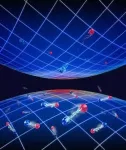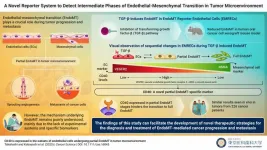(Press-News.org) A research team led by Professors PAN Jianwei, YAO Xingcan, and CHEN Yu'ao from the University of Science and Technology of China (USTC) of the Chinese Academy of Sciences, have for the first time observed and quantitatively characterized the many-body pairing pseudogap in unitary Fermi gases. This achievement, pursued by the ultracold atomic community for nearly two decades, resolves longstanding debates regarding the existence of a pairing pseudogap in these gases. It also supports pairing as a possible origin of the pseudogap in high-temperature superconductors, within the framework of preformed-pair superconductivity theory.
Published in Nature on Feb. 7, this study coincides with the upcoming Year of the Dragon. Interestingly, the physics behind this achievement can be vividly illustrated by the iconic Chinese myth of "Carp Jumping Over the Dragon Gate," symbolizing great success in Chinese culture.
The existence of an energy gap is a hallmark phenomenon of superconductivity. In conventional superconductors, the energy gap exists below the superconducting transition temperature (Tc). Remarkably, in cuprate high-temperature superconductors, the energy gap can still be observed even above Tc, a phenomenon known as the pseudogap. Understanding the origin and nature of the pseudogap is crucial for grasping the mechanism of high-temperature superconductivity, particularly regarding how Cooper pairs form and establish long-range phase coherence.
There are two main hypotheses for the pseudogap's origin: It results from strong pair fluctuations, manifesting as preformed electron pairs above Tc and serving as a precursor to coherent pair condensation; and it arises from various quantum orders in high-temperature superconductors, such as the antiferromagnetic order, stripe phase, and pair density wave. Yet the complexity of high-temperature superconducting materials leaves these questions largely unanswered.
Unitary Fermi gases provide an ideal quantum simulation platform for investigating the existence and characteristics of a pairing pseudogap. This may be attributed to their unprecedented controllability, purity, and, most importantly, the presence of known short-range attractive interactions. Additionally, the absence of a lattice structure in bulk Fermi gases eliminates the influence of competing quantum orders. In this context, previous experiments have measured the trap-averaged single-particle spectral function of strongly interacting Fermi gases. However, these experiments have not provided convincing evidence of a pseudogap, primarily due to the inhomogeneity of the trap and serious issues arising from final-state interactions in the commonly used rf spectroscopy.
After years of dedicated work, the USTC research team has established a quantum simulation platform using ultracold lithium and dysprosium atoms, and has achieved a state-of-the-art preparation of homogeneous Fermi gases (Science). Additionally, this team developed novel techniques to stabilize the required magnetic fields. At a magnetic field of approximately 700 G, the short-term fluctuations achieved are below 25 μG, resulting in a record-high relative magnetic field stability. This ultra-stable magnetic field enabled the research team to use microwave pulses to excite atoms to high-lying energy states that do not interact with the initial states, thereby realizing momentum-resolved photoemission spectroscopy.
With these two crucial technical breakthroughs, the research team systematically measured the single-particle spectral function of unitary Fermi gases at different temperatures and observed the existence of the pairing pseudogap, lending support for the role of preformed pairing as a precursor to superfluidity.
Furthermore, the research team determined the pairing gap, pair lifetime, and single-particle scattering rate from the measured spectral function, which are essential quantities for characterizing the behavior of strongly interacting quantum systems. These findings not only advance the study of strongly correlated systems, but also provide valuable insights and information for establishing a proper many-body theory. The techniques developed in this work lay the foundation for future exploration and study of other important low-temperature quantum phases, such as single-band superfluidity, stripe phases, and Fulde–Ferrell–Larkin–Ovchinnikov superfluidity.
END
Quantum simulation with ultracold fermions unveils pairing pseudogap
2024-02-07
ELSE PRESS RELEASES FROM THIS DATE:
New research uncovers biological drivers of heart disease risk
2024-02-07
New gene mapping technique reveals how genetic alterations in cells lining blood vessels contribute to coronary artery disease, with implications for diagnostic and treatment strategies.
KEY TAKEAWAYS
Researchers from the Brigham, the Broad Institute, and Stanford Medicine studied how "deleting" individual genes associated with coronary artery disease (CAD) impacted the expression of all the other genes in a cell to better understand underlying biology of CAD.
The study focused on endothelial cells, which line blood vessels and are increasingly understood to influence CAD risk.
The researchers highlighted a previously unrecognized role for the TLNRD1 gene ...
Resting boosts performance of lithium metal batteries
2024-02-07
Next-generation electric vehicles could run on lithium metal batteries that go 500 to 700 miles on a single charge, twice the range of conventional lithium-ion batteries in EVs today.
But lithium metal technology has serious drawbacks: The battery rapidly loses its capacity to store energy after relatively few cycles of charging and discharging – highly impractical for drivers who expect rechargeable electric cars to operate for years.
Scientists have been testing a variety of new materials and techniques to improve the battery’s cycle life. Now, Stanford University researchers have discovered a low-cost solution: simply drain the battery and let it rest for several hours. ...
Machine learning models for predicting disability and pain following lumbar disc herniation surgery
2024-02-07
About The Study: The findings of this study including 22,000 surgical cases suggest that machine learning models can inform about individual prognosis and aid in surgical decision-making to ultimately reduce ineffective and costly spine care.
Authors: Bjørnar Berg, Ph.D., of Oslo Metropolitan University in Oslo, is the corresponding author.
To access the embargoed study: Visit our For The Media website at this link https://media.jamanetwork.com/
(doi:10.1001/jamanetworkopen.2023.55024)
Editor’s ...
Using cancer’s strength to fight against it
2024-02-07
Current immunotherapies work only against cancers of the blood and bone marrow
T cells engineered by Northwestern and UCSF were able to kill tumors derived from skin, lung and stomach in mice
Cell therapies can provide long-term immunity against cancer
CHICAGO --- Scientists at the UC San Francisco (UCSF) and Northwestern Medicine may have found a way around the limitations of engineered T cells by borrowing a few tricks from cancer itself.
By studying mutations in malignant T cells that cause lymphoma, they zeroed in on one that imparted ...
Trends in stroke thrombolysis care metrics and outcomes by race and ethnicity
2024-02-07
About The Study: In this study of more than 1 million patients with stroke, the Target: Stroke quality initiative was associated with improvement in thrombolysis frequency, timeliness, and outcomes for all racial and ethnic groups. However, disparities persisted, indicating a need for further interventions.
Authors: Gregg C. Fonarow, M.D., of the University of California, Los Angeles, is the corresponding author.
To access the embargoed study: Visit our For The Media website at this link ...
New direct links discovered between the brain and its surrounding environment
2024-02-07
In a recent study of the brain’s waste drainage system, researchers from Washington University in St. Louis, collaborating with investigators at the National Institute of Neurological Disorders and Stroke (NINDS), a part of the National Institute of Health (NIH), discovered a direct connection between the brain and its tough protective covering, the dura mater. These links may allow waste fluid to leave the brain while also exposing the brain to immune cells and other signals coming from the dura. This challenges the conventional wisdom which has suggested that the brain is cut off from its ...
Stress influences brain and psyche via immune system
2024-02-07
Chronic stress has far-reaching consequences for our bodies. For example, many stress-related psychiatric illnesses such as depression are associated with changes in the immune system. However, the underlying mechanisms of how these changes affect the brain are still largely unknown.
Enzyme from immune cells in the blood affects nerves in the brain
An international research team led by the University of Zurich (UZH), and the University Hospital of Psychiatry Zurich (PUK) and the Icahn School of Medicine at Mount Sinai, New York, has now uncovered a novel mechanism. “We were able to show that ...
Mimas' surprise: Tiny moon holds young ocean beneath icy shell
2024-02-07
Hidden beneath the heavily cratered surface of Mimas, one of Saturn's smallest moons, lies a secret: a global ocean of liquid water. This astonishing discovery, led by Dr. Valéry Lainey of the Observatoire de Paris-PSL and published in the journal Nature, reveals a "young" ocean formed just 5 to 15 million years ago, making Mimas a prime target for studying the origins of life in our Solar System.
“Mimas is a small moon, only about 400 kilometers in diameter, and its heavily cratered surface gave no hint of the hidden ocean beneath," says Dr Nick Cooper, ...
Quantum materials: Discovered new state of matter with chiral properties
2024-02-07
An international research group has discovered a new state of matter characterized by the existence of a quantum phenomenon called chiral current. These currents are generated on an atomic scale by a cooperative movement of electrons, unlike conventional magnetic materials whose properties originate from the quantum characteristic of an electron known as spin and their ordering in the crystal.
Chirality is a property of extreme importance in science, for example, it is fundamental also to understand DNA. ...
Towards a better understanding of endothelial cell transformation in cancer progression
2024-02-07
In a new study, Tokyo Medical and Dental University researchers shed light on partial endothelial-to-mesenchymal transition in the tumor microenvironment
Tokyo, Japan - Endothelial-mesenchymal transition (EndoMT, also termed as EndMT), a biological process resulting in the formation of mesenchymal (or lineage-committed) phenotypes from endothelial cells (lining blood vessels), plays a crucial role in tumor progression. Despite the important role of EndoMT, the underlying mechanism and characteristics of cells in intermediate/partial EndoMT remain largely unexplored. Now, researchers from Japan have developed a system to study these EndoMT stages.
In ...


